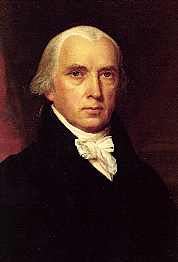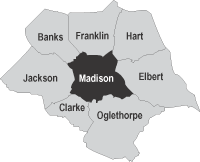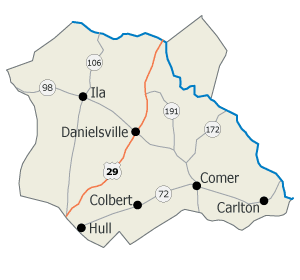This contains no postmark or other means of identifying the date of its printing and use. The address side of the card does not have a space for a personal message. Since federal law prohibited personal messages on the address side before March 1907, this postcard likely was printed before 1907.
The brick structure — Madison County’s third courthouse — was completed in 1901. It replaced a frame courthouse, which in turn replaced an earlier wooden courthouse.The courthouse was rehabilitated in 1983, but lack of space led county officials to move to the present courthouse in 1996. A restoration of the roof took place in 1999-2000, but the structure has been vacant since 1996 — and its future use is uncertain. The old courthouse square features a statue of Dr. Crawford Long [see photo], who was born in Danielsville in 1815.
Madison County’s present courthouse — the fourth in the county’s history — was constructed in 1996-97. It replaced the old courthouse, which still stands on the downtown courthouse square. The previous structure, built in 1901, replaced a frame courthouse, which in turn replaced an earlier wooden courthouse–all three built on the same site. Eventually, the old courthouse proved too small for county government needs, forcing the county to rent office space in downtown Danielsville. In the mid-1990s, the county commission decided to use the former Danielsville Elementary School two blocks away as the core of a new and much larger county courthouse/government complex. The old school underwent a substantial renovation in 1996, with the actual courtroom and judicial offices part of a new addition to the old school in 1997– all within a newly designed exterior. The result was essentially a new courthouse, although its official title is “Madison County Government Complex.”
Madison County History
Madison County, Georgia
December 5, 1811 Madison County created
Creation of Georgia Counties November 1, 1815
Crawford Long born, Danielsville (Madison County), Georgia

Name derivation: Named in honor of James Madison, President of the United States who visited the state during his term of office and traveled through the Cherokee Nation to Nashville.
Madison County was created by the Georgia Legislature in 1811 and was formed from portions of Clarke, Elbert, Franklin, Jackson and Oglethorpe Counties. It is the 38th county in the state and was named for the nation’s fourth president, James Madison. The first meeting of county government was in January 1812 at the “Strickland House” currently being used as the offices of the Chamber of Commerce and Industrial Authority. In 1773, the Cherokee Indians ceded to the Colonial Government of Georgia a large tract of land, whose western border included what is now Madison County. Governor James Wright sold farms of 100 to 1,000 acres to settlers who came to Georgia from similar areas of Pennsylvania, Virginia and North and South Carolina.
These early residents probably were hunters, squatters, traders and cattle-raisers. Although they did not leave written records, landmarks, such as churches, trading places and cattle raising centers are known to have been in existence since 1790.
More About Madison County
 Madison County, the 38th county formed in Georgia, was created in 1811 from parts of Clarke, Elbert, Franklin, Jackson and Oglethorpe counties. It was named for President James Madison.
Madison County, the 38th county formed in Georgia, was created in 1811 from parts of Clarke, Elbert, Franklin, Jackson and Oglethorpe counties. It was named for President James Madison.
The county has six municipalities, with Danielsville serving as the county seat. The other communities are Carlton, Colbert, Comer, Hull and Ila. No municipality in Madison County has a population over 1,000; only one, Comer, exceeds 500.
Crawford W. Long, the first doctor to use ether in surgery, was born in Danielsville in 1815.
Madison and Oglethorpe counties share Watson Mill Bridge State Park, the site of the longest covered bridge in Georgia. The bridge, which is over 100 years old, spans 229 feet of the South Fork of the Broad River.
The Madison County Courthouse, one of the most ornate in Georgia, was built in 1901 for the sum of $18,314. It is listed on the National Register of Historic Places. New Hope Presbyterian Church, established in 1788, is the third oldest church in Georgia. The courthouse is no longer occupied by government offices and is currently under restoration.
 The Madison County Government Complex now houses some of the government offices and the courts. Situated at 91 Albany Avenue, in Danielsville, and within view of the Historic Courthouse, the Complex was previously the site of the Danielsville Elementary School. The building was renovated and has been occupied since June 1997.
The Madison County Government Complex now houses some of the government offices and the courts. Situated at 91 Albany Avenue, in Danielsville, and within view of the Historic Courthouse, the Complex was previously the site of the Danielsville Elementary School. The building was renovated and has been occupied since June 1997.
Madison County was developed over the course of 2 centuries. It’s history is similar to the whole history of NE Georgia. When the Revolutionary War ended, Georgia acquired an immense area of land through a treaty with the Cherokee Indians in 1783. The wilderness had isolated settlements of Creek and Cherokee Indians. The first white settlers were hunters, traders, squatters, and cattle raisers who migrated from the Carolinas and Virginia.
What encouraged settlements in the area were the headright land grants awarded to Revolutionary War soldiers as payment for their loyal service. From 1788 to 1795, settlers coming into the area were mostly from Pennsylvania, Virginia, N. and S. Carolina. Landmarks such as churches, trading places, and cattle-raising centers are known to have existed as early as 1790. Farming was the way of life. Several forts were built covering a large geographic area. Madison County had 4 of them – Hillhouse Forge was on South Fork of the Broad River, near Comer, Hillhouse Furnace near Rogers Mill, Jones Station (later named Fort Lamar), and Black Station near Black’s Creek and the Hudson River.
Madison County became Georgia’s 38th county in 1811 and named for James Madison, the 4th President and chief architect of the U.S. Constitution. Danielsville was founded in 1812 and became the county seat. It was named for General Allen Daniel, a Revolutionary War veteran and prominent person. This Courthouse was built in 1901. A statue of Dr. Crawford W. Long, a Civil War physician and native. He was the first physician to successfully use ether as an anesthetic, and his boyhood home still stands.
Comer (formerly known as Honey Pot) is Madison County’s most populous town. The residents had the town’s center designated as a historic district. Downtown Colbert has been listed on the National Register of Historic Places for over 20 years. Colbert was originally known as Five Forks because 5 principal roads met there leading to Danielsville, Diamond Hill, Comer, Crawford, and Athens. The Colbert railway station, built in 1892, sits in the center of historic downtown. It was restored in 1974 and now houses Colbert City Hall and Colbert Museum. Across the street are 2 historic structures that have been moved here: the Jacob Eberhart Cabin (built by one of Colbert’s first settlers), and the old Grove Hill District Courthouse, presently used by the Sons of Confederate Veterans and includes The Garden of Remembrance. Ila is at the western end. The historic outpost of Fort Lamar flourished near the town’s present site. Hull was organized around a chapel known as Hull’s Meeting House. Hope Hull, one of the earliest Methodist ministers, built the Chapel and served as a trustee of the University of Georgia. Hull’s first post office was known as Dowdy and was located on Spratlin Mill Road. Unincorporated communities remain such as: Sanford (formerly Sawdust), Neese, Pocataligo, Fort Lamar, Jot-Em-Down, Booger Hill, Vineyard’sCreek, and Dogsboro. Paoli is listed on the National Register. Other attractions include: Watson Mill Covered Bridge (the longest bridge remaining in Georgia) and State Park, Colbert Museum, The Strickland House, Colbert Railway Station, Camp Kiwanis, and the Broad River
